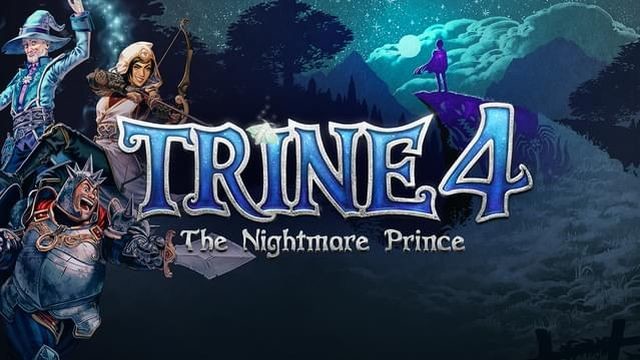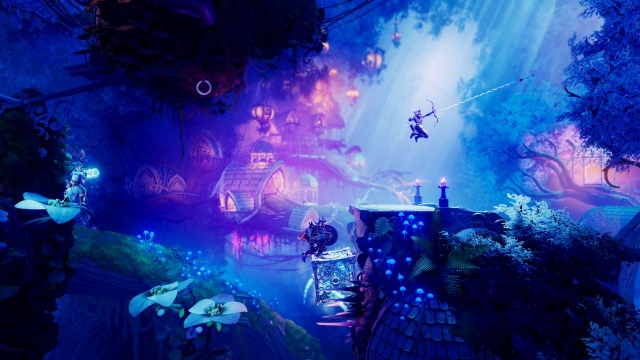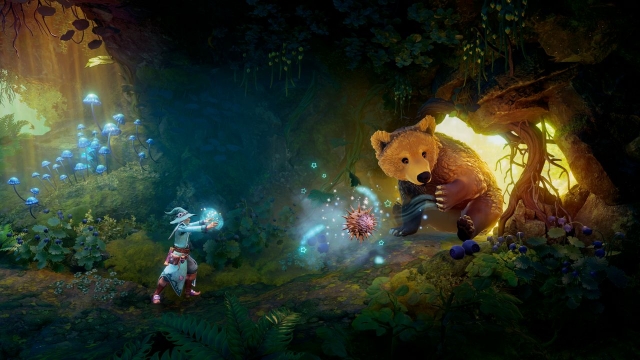Trine 4: The Nightmare Prince

The Good: Yay! Another Trine! Oooh, so pretty!
The Bad: Puzzles seem less flexible in their solution.
The Ugly: Nothing.
If you had asked me when Trine came out (2009), how many sequels I thought it could support, I would have said two, maybe three if they push it. The core game mechanic, that of a side scroller which allows the player to call upon any of three different characters – a thief, a wizard, and a knight – one at a time to solve environmental puzzles, is interesting, and starting the series out the developers were really clever in that the puzzles had different ways in which different characters could solve them, but how long could they possibly keep going? The iffy and all around unsatisfying Trine 3 certainly made it seem like the idea had run its course. So it kind of surprised me when Trine 4 showed up on my desktop, but I went in with an open mind (though with eyes squinted in trepidation). What I found is some new mechanics that manage to keep the puzzles fresh, though in some ways restrict the ability of the player to creatively solve the different puzzles in multiple ways, resulting in a nicely polished package that’s pretty short, but a lot of fun to play.
In the first game, Trine told the story of three characters sort of fused together by a magic artifact (T4 doesn’t mention this bit of world-building lore except as an aside, so I suppose it’s up to the player to just know and/or accept it). The different characters have different skills (which can be improved or modified through a skill tree). The wizard has telekinesis and the ability to conjure objects out of thin air. The thief has a bow that can be used as a weapon or can fire rope arrows for climbing and swinging. The knight has a shield and sword for combat, but can also use the surface of his shield to reflect beams of light. While undeniably the characters have situations in which they are better suited – for example I tend to use the knight for all combat, as I find the firing rate of the thief’s arrows too slow – most of the puzzles have at least a couple of different ways in which to solve them. If I have to break a barrier, I can use an arrow or sword, but I can also conjure an object and use telekinesis to drive it like a ram. If I have to bridge a pit, I can either conjure objects to fill the pit and walk across, use the knight sprint ability to zip across, or maybe swing across on a rope arrow. On occasion, in the first game, I would see how far I could get before a puzzle absolutely required me to switch characters. Huge chunks could be solved with just the wizard (if desperate, in combat, you can conjure objects and use telekinesis to pummel your enemies, but it takes practice).
Trine 4 has added a bunch of new skills to the list, and while this has opened up the types of the puzzles that can be created, it has also limited which characters can solve them and how they can be solved. For example, I have to ring a bell through a narrow set of bars. Telekinesis doesn’t work on it. The knight can’t get close to it. The only solution I’ve found is to shoot an arrow at it. I need to reflect a beam of light onto a sensor, and the things the wizard conjures don’t reflect light. Only the knight’s shield can do that. I need to tip a scale and no other objects are around to move, so the wizard must conjure one and place it on the scale. The question for Trine has gone from “How can I solve this puzzle?” to “How did the designers intend me to solve this puzzle?” And I think sometimes this makes it less fun.
Among the new bits: The thief now has elemental arrows, such as fire that can be used to melt ice, and ice arrows that can freeze objects in place. The ice arrows can also create ice floes which you can stand on or place objects on. The knight has a sprint ability, which can be used to slam into objects which in turn slam into other objects. The places where you are supposed to use these to solve puzzles are glaringly obvious, and adds to my overarching complaint of having to solve the puzzles a certain way.
Trine remains a beautiful game. Have the graphics changed from the previous iterations? – I don’t know as I’d have to reinstall one of the old games and check – but they feel much the same. The areas are brightly colored and wonderfully detailed with a whimsical, cartoonish style. Characters and objects are neatly and smoothly animated. Spells are appropriately glittery, and the mechanics of throwing objects and swinging on ropes is for the most part realistic within the physics of this world, though sometimes it’s not quite clear how relative masses work out. Is the wizard heavier or lighter than the box they conjure? It isn’t really clear.
There is a coop component in which you and a friend can solve puzzles together. I don’t have anyone in my Steam friends list playing it, so I went with a random matchup. The pairing was smooth and I found a game quickly. You can’t play the same character at the same time, so if both of you has a favorite, that might not work out that well. I don’t know if the game supports a voice channel – I don’t own a mic – but I couldn’t find a chat function either. This means that, rather than working together and pitching ideas to solve the puzzles, you often have someone figure out the puzzle first and just solve it while the other person watches. Many puzzles can be solved by a single character anyway. I also found that both times I played multiplayer it was in a section of the game I had already played through, and at least one player clearly hadn’t played it before, so he mostly just followed along as I went ripping through puzzles I had already solved. If you were playing with an actual friend, the coop would be more fun, but with just some random person I wasn’t thrilled by the experience.
Overall, I think Trine remains a clever little side-scrolling puzzler, which, four iterations in, is a genuinely pleasant surprise for me. The puzzles remain fresh, and build kind of organically as the game progresses, so the difficulty curve is rather constant throughout. The multiplayer isn’t all that great unless you have a friend and a yen to really play it that way. I’m at about the 75% point in just four hours of play, so I think something like 5-7 hours is about what you’ll get out of it, multiplayer aside. I seem to recall in an earlier review that I said that Trine takes the side scroller about as far as it can go, and I think that remains true of Trine 4 as well.
Reviewed By: Phil Soletsky
Publisher: Modus Games
Rating: 80%
——————————————————————————–
This review is based on a digital copy of Trine 4: The Nightmare Prince for the PC provided by Modus Games.
 Game Over Online
Game Over Online





